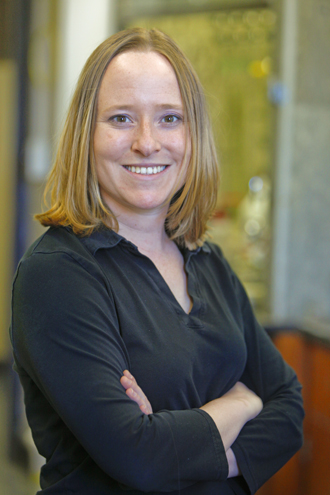Christine Thomas experiments on NOVA
Hunting the Elements premieres Wednesday, April 4 at 9 p.m.
 Photo/Mike Lovett
Photo/Mike LovettChristine Thomas
Fewer than 100 naturally occurring elements make up everything in our world — from rocks to the living cells in our body. Researchers at NOVA say they wanted to know why some elements, like platinum or gold, are inert while others, like phosphorus or potassium, are violently explosive. Why are some vital to every breath we take while others are lethal toxins that killed off their discoverers, such as Marie Curie?
The NOVA segment “Hunting the Elements” which premieres at 9 p.m. Wednesday, April 4, on PBS features David Pogue, host of NOVA’s “Making Stuff” series and personal technology correspondent for The New York Times. He engages viewers through hands-on experiments, including some with Christine Thomas, assistant professor of chemistry, on the Brandeis campus.
The segment is on the elements of life, specifically carbon (C), hydrogen (H), nitrogen, (N) oxygen (O), phosphorus (P) and sulfur (S). Thomas says that, although her work at Brandeis focuses more on the chemistry of the transition metals, C, H, N, O, P and S play important roles in tuning the reactivity of the metals she works with.
“Our lab, and many other transition metal chemists, take a lot of lessons from mother nature when designing our catalysts, using a lot of the same elements,” says Thomas.
Pogue and Thomas do a number of demonstrations in the NOVA segment. One of the most important ones, Thomas says, illustrates the proportions of C, H, N, O, P, and S in the human body by taking a trip to the hardware store and buying household items that contain amounts of the elements equivalent to those in a 185-pound man.
“We also talked about these elements in their elemental form, and how it was first discovered that oxygen and hydrogen support combustion while nitrogen does not,” says Thomas.
Another demonstration includes a reenactment of the first isolation of an element – phosphorus -- in its elemental form.
“It was discovered serendipitously when an alchemist named Henning Brand separated it from cow urine,” says Thomas. “He, like many alchemists of his time, was looking for gold.”
Thomas says she was very excited to be involved in an educational program.
Chris Schmidt, co-executive producer, says NOVA was looking for someone who could help Pogue understand the role that the elements play in living things, and also make concrete the amounts of those elements in a human body and the relative proportions.
Thomas was brought on board through Paula Apsell '69, NOVA’s senior executive producer and a member of the Brandeis University Science Advisory Council (BUSAC).
“I was very interested in making a show on the periodic table, as it really reflects our understanding of matter,” says Apsell. “I’ve always been fascinated by that as an amazing device for organizing nature.”
Apsell studied psychology at Brandeis and worked in one of the physics labs. She says there was a way of thinking about science at Brandeis that really nurtured her interest.
“It was a whole culture that valued science and research,” says Apsell. “I certainly think that that had a very profound influence on me.”
The two-hour program will feature NOVA’s first iPad app, which will launch April 3, the day before “Hunting the Elements” premieres. The app is designed to entertain and educate.
“In our technologically challenging age, science education is important for people of all ages and backgrounds,” says Thomas. “I was happy to be part of developing and playing a role in a NOVA special meant to bring a better appreciation of chemistry to a general audience.”
Categories: Research, Science and Technology





